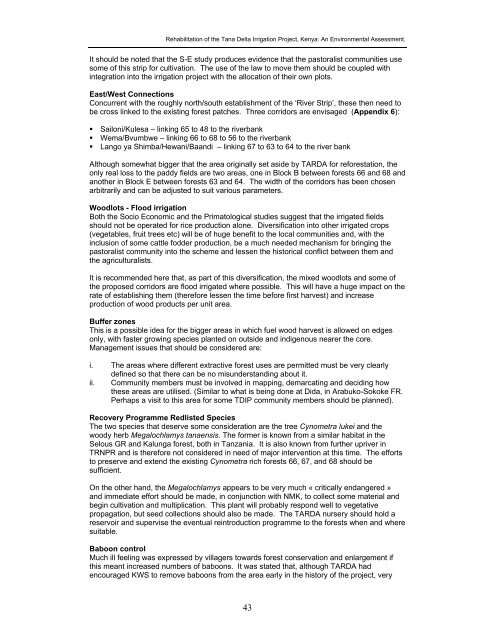Tana Delta Irrigation Project, Kenya: An Environmental Assessment
Tana Delta Irrigation Project, Kenya: An Environmental Assessment
Tana Delta Irrigation Project, Kenya: An Environmental Assessment
Create successful ePaper yourself
Turn your PDF publications into a flip-book with our unique Google optimized e-Paper software.
Rehabilitation of the <strong>Tana</strong> <strong>Delta</strong> <strong>Irrigation</strong> <strong>Project</strong>, <strong>Kenya</strong>: <strong>An</strong> <strong>Environmental</strong> <strong>Assessment</strong>.<br />
It should be noted that the S-E study produces evidence that the pastoralist communities use<br />
some of this strip for cultivation. The use of the law to move them should be coupled with<br />
integration into the irrigation project with the allocation of their own plots.<br />
East/West Connections<br />
Concurrent with the roughly north/south establishment of the ‘River Strip’, these then need to<br />
be cross linked to the existing forest patches. Three corridors are envisaged (Appendix 6):<br />
• Sailoni/Kulesa – linking 65 to 48 to the riverbank<br />
• Wema/Bvumbwe – linking 66 to 68 to 56 to the riverbank<br />
• Lango ya Shimba/Hewani/Baandi – linking 67 to 63 to 64 to the river bank<br />
Although somewhat bigger that the area originally set aside by TARDA for reforestation, the<br />
only real loss to the paddy fields are two areas, one in Block B between forests 66 and 68 and<br />
another in Block E between forests 63 and 64. The width of the corridors has been chosen<br />
arbitrarily and can be adjusted to suit various parameters.<br />
Woodlots - Flood irrigation<br />
Both the Socio Economic and the Primatological studies suggest that the irrigated fields<br />
should not be operated for rice production alone. Diversification into other irrigated crops<br />
(vegetables, fruit trees etc) will be of huge benefit to the local communities and, with the<br />
inclusion of some cattle fodder production, be a much needed mechanism for bringing the<br />
pastoralist community into the scheme and lessen the historical conflict between them and<br />
the agriculturalists.<br />
It is recommended here that, as part of this diversification, the mixed woodlots and some of<br />
the proposed corridors are flood irrigated where possible. This will have a huge impact on the<br />
rate of establishing them (therefore lessen the time before first harvest) and increase<br />
production of wood products per unit area.<br />
Buffer zones<br />
This is a possible idea for the bigger areas in which fuel wood harvest is allowed on edges<br />
only, with faster growing species planted on outside and indigenous nearer the core.<br />
Management issues that should be considered are:<br />
i. The areas where different extractive forest uses are permitted must be very clearly<br />
defined so that there can be no misunderstanding about it.<br />
ii. Community members must be involved in mapping, demarcating and deciding how<br />
these areas are utilised. (Similar to what is being done at Dida, in Arabuko-Sokoke FR.<br />
Perhaps a visit to this area for some TDIP community members should be planned).<br />
Recovery Programme Redlisted Species<br />
The two species that deserve some consideration are the tree Cynometra lukei and the<br />
woody herb Megalochlamys tanaensis. The former is known from a similar habitat in the<br />
Selous GR and Kalunga forest, both in Tanzania. It is also known from further upriver in<br />
TRNPR and is therefore not considered in need of major intervention at this time. The efforts<br />
to preserve and extend the existing Cynometra rich forests 66, 67, and 68 should be<br />
sufficient.<br />
On the other hand, the Megalochlamys appears to be very much « critically endangered »<br />
and immediate effort should be made, in conjunction with NMK, to collect some material and<br />
begin cultivation and multiplication. This plant will probably respond well to vegetative<br />
propagation, but seed collections should also be made. The TARDA nursery should hold a<br />
reservoir and supervise the eventual reintroduction programme to the forests when and where<br />
suitable.<br />
Baboon control<br />
Much ill feeling was expressed by villagers towards forest conservation and enlargement if<br />
this meant increased numbers of baboons. It was stated that, although TARDA had<br />
encouraged KWS to remove baboons from the area early in the history of the project, very<br />
43

















